Chapter 12 - International Trade
12.1 Comparative Advantage and Gains from Trade
- Law of comparative advantage - It says that nations can mutually benefit from trade so long as the relative production costs differ.
- This is at the macroeconomic level.
Comparative and Absolute Advantage
Comparative advantage - When a company can produce a good at a lower opportunity cost than another.
Absolute advantage - When a company has the capability to produce more of the same good than another.
Trade doesn’t rely on absolute advantages. It relies on comparative advantages.

In this table, Indiana can produce soybeans at a cost that is lower than Oregon’s cost of soybeans, it has a comparative advantage in soybeans. Oregon can produce timber at a lower cost than Indiana's cost of timber, so it has a comparative advantage in timber production.
Indiana should specialize in soybean production.
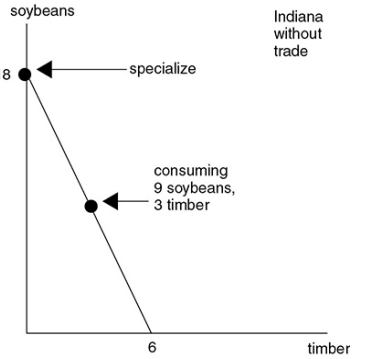
Oregon should specialize in timber production.
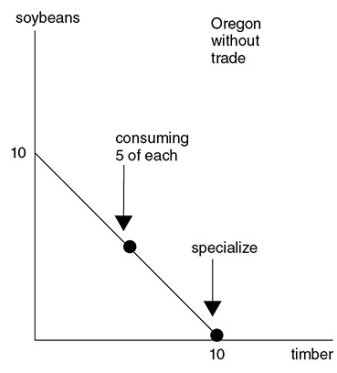
Gains from Trade
If Oregon produces 10 timbers and sends 5 to Indiana in exchange for 9 soybeans, they get 9 soybeans but only give up 5 timbers. The cost of giving up 1 timber is now is 5/9, which is less than 1 timber.
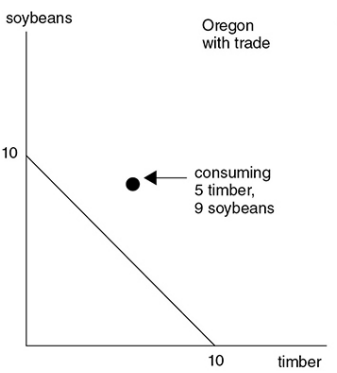
If Indiana produces 18 soybeans and sends 9 to Oregon in exchange for 5 timbers, they get 5 timbers and only give up 9 soybeans. The cost now is 9/5, which is less than 3 soybeans.
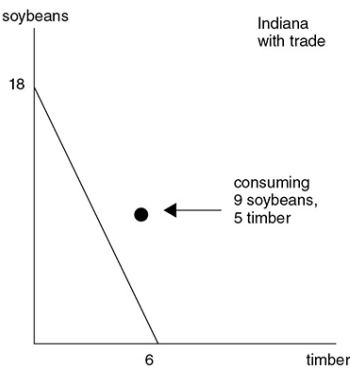
Consumption Frontier
Consumption possibility frontier - The line that connects Indiana’s specialization of soybeans to Oregon’s specialization of timber.
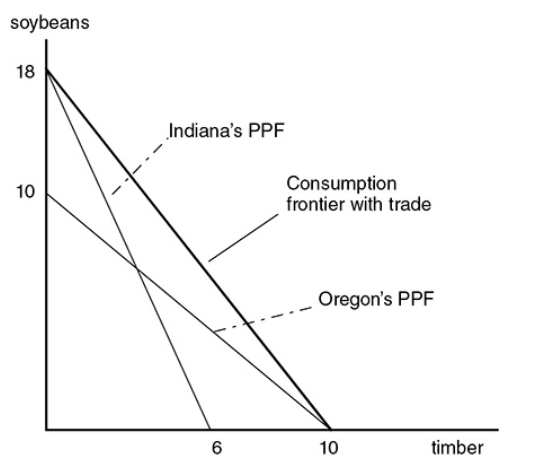
If the opportunity costs of production are different, the two economies find it mutually beneficial to specialize and trade.
If you have a comparative advantage in the production of a good, specialize in the production of that good and trade for the other.
Specialization and trade allow nations to consume beyond the PPC.
Free trade (i.e., without trade barriers) based on comparative advantage allows for a more efficient allocation of resources and greater prosperity for the trading partners than can be achieved without free trade.
Exports, Imports, and the World Price
- World price - The global equilibrium price of a good when nations engage in trade.
- Domestic price - The equilibrium price of a good in a nation without trade.
- If the world price of a good is above the domestic price, the nation becomes an exporter of that good.
- If the world price of a good is below the domestic price, the nation becomes an importer of that good.
Domestic Market Without Trade
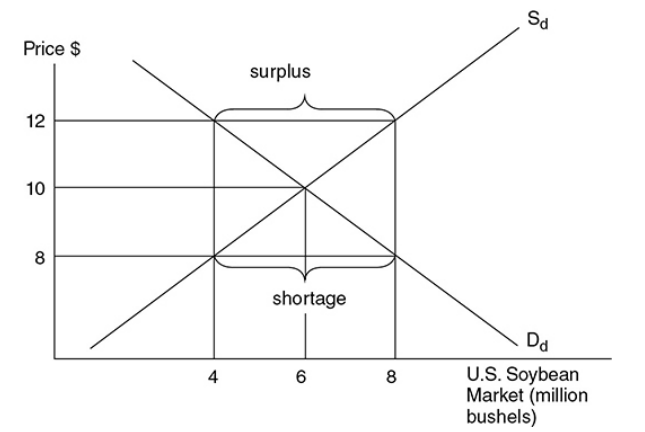
- This portrays the competitive U.S. market for soybeans without trade. The competitive price of $10 per bushel is found at the intersection of domestic demand and supply. At this point, six million bushels are produced.
World Market with Trade
- ^^Ex. →^^ If the United States begins to trade soybeans with other nations, the world price may rise above or fall below $10. If the world price falls to $8, there exists a shortage of soybeans in the U.S. market. Domestic producers supply only four million bushels, but domestic consumers demand eight million bushels. The United States must then import the difference of four million bushels. If the world price rises to $12, there is a four-million-bushel surplus in the U.S. market and the United States exports this surplus.
12.2 Balance of Payments
Balance of Payments Accounts
- Balance of payments statement - A summary of the payments received by the United States from foreign countries and the payments sent by the United States to foreign countries.
Current Account
Current account - This account shows current import and export payments of both goods and services and investment income sent to foreign investors of the United States and investment income received by U.S. citizens who invest abroad.
- ^^Ex. →^^ If a Canadian is receiving dividends from an American corporation or interest from a U.S. Treasury bill, these dollars would be sent out of the country.
- A deficit balance tells us that the United States sent more American dollars abroad than foreign currency received in current transactions.
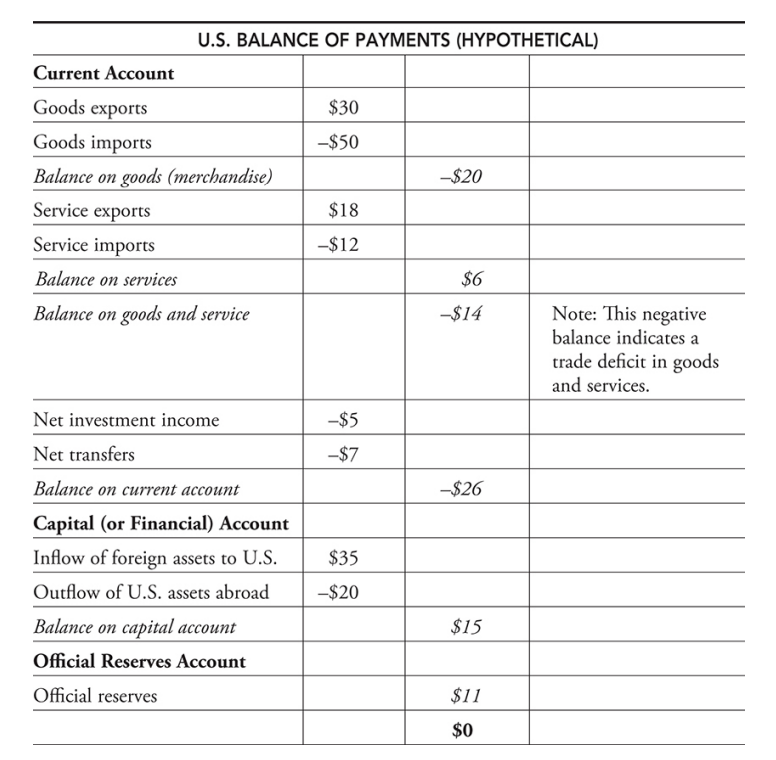
Capital (or Financial) Account
- Capital (or financial) account - This account shows the flow of investment on real or financial assets between a nation and foreigners.
- ^^Ex. →^^ If a Swedish firm buys a manufacturing facility in Idaho, or if a Mexican citizen buys a U.S. Treasury bond, it is recorded as an inflow of foreign capital assets into the United States.
- A surplus balance tells us that there was more foreign capital investment in the United States than there was U.S. investment abroad.
Official Reserves Account
- Official reserves account - The Fed’s adjustment of a deficit or surplus in the current and capital account by the addition or subtraction of foreign currencies so that the balance of payments is zero.
- Balance of payments deficit - When the US has sent more dollars out than foreign currency has come in while adding the current and capital account. When this happens, the Fed credits the account to balance it.
- Balance of payment surplus - When more foreign currency was coming into the US than American dollars sent abroad. Here, the Fed transfers the surplus currency bank into official reserves.
A Circular Flow of Dollars
- The U.S. dollars that Americans send to foreigners are equal to the U.S. dollars that foreigners send to Americans.
- If Americans import more goods and services from abroad, the current account will move in the deficit direction but the capital/financial account will move in the surplus direction as those dollars return.
12.3 Foreign Exchange Rates
Currency Markets
Exchange rate - The price of one currency in terms of a second currency.
^^Ex. →^^ If 2 dollars = 1 euro, 1 dollar = 0.5 euro.

Appreciating and Depreciating Currency
Appreciating or stronger currency - When the value of a currency is rising relative to another currency.

Depreciating or weaker currency - When the value of a currency is falling relative to another currency.
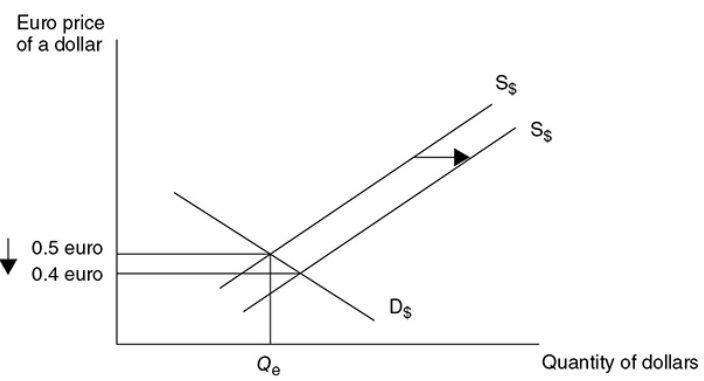
- NOTE - It is very important to label the axes correctly. If the market is for the dollar, the x-axis should be labeled “Quantity of dollars.” The label on the y-axis depends on how the dollar is being priced. If we are pricing dollars in terms of the number of euros it takes to purchase 1 dollar, then the correct label is “Euros per dollar” or “Euro price of a dollar”.
Changes in Exchange Rate
- Determinants of exchange rates - External factors that increase the price of one currency relative to another.
- Consumer tastes - When domestic consumers build a stronger preference for foreign-produced goods and services, the demand for those currencies increases and the dollar depreciates. If foreign consumers increase their demand for U.S.-made goods, the dollar appreciates.
- Relative incomes - When a nation’s macroeconomy is strong and incomes are rising, they increase their demand for all goods, including those produced abroad.
- ^^Ex. →^^ If Europeans are enjoying economic growth and the United States is in a recession, the relative buying power of European citizens is growing, meaning that the consumption of domestic and U.S.-made goods increases demand for the dollar appreciating its value.
- Speculation - Foreign currencies can be traded as assets causing investors to seek to profit from buying currency at a low rate and selling it at a higher rate.
- ^^Ex. →^^ If it appears that future interest rates will fall in the United States relative to interest rates in Japan, the yen seems like a good investment. Speculators would then increase their demand for Japanese assets, thus appreciating the yen and depreciating the dollar.
Connection to Monetary Policy
. When the Fed increases the money supply, the interest rates on American financial assets begin to fall, so the demand for the dollar falls and it depreciates relative to other foreign currencies.
- This makes goods in the US less expensive to foreign consumers, so American net exports increase shifting AD to the right.
If the Fed decreases the money supply, American interest rates begin to rise and the dollar appreciates relative to foreign currencies.
- This makes American goods more expensive decreasing the net exports which shifts AD to the left.
When interest rates rise, capital investments decrease and financial investments increase.

Demand for the U.S. dollar increases and the dollar appreciates relative to the euro if:
- European taste for American-made goods is stronger.
- European relative incomes are rising, increasing demand for U.S. goods.
- The U.S. relative price level is falling, making U.S. goods relatively less expensive.
- Speculators are betting on the dollar to rise in value.
- The U.S. relative interest rate is higher, making the United States a relatively more attractive place for financial investments
12.4 Trade Barriers
Tariffs
Revenue tariff - An excise tax levied on goods not produced in the domestic market.
- ^^Ex. →^^The United States does not produce bananas. If a revenue tariff were levied on bananas, it would not be a serious impediment to trade, and it would raise a little revenue for the government.
Protective tariff - An excise tax levied on a good that is produced in the domestic market so that it may be protected from foreign competition.
^^Ex. →^^ Assume the domestic price for steel is $100 per ton and the equilibrium quantity of domestic steel is 10 million tons. Since other nations could produce it at a lower cost, in the competitive world market, the price is $80 per ton. At that price, the United States would demand 12 million tons but only produce eight million tons and so four million tons are imported. If the steel industry is successful in getting a protective tariff passed through Congress, the world price rises by $10, increasing the quantity of domestic steel supplied and reducing the amount of steel imported from four million to two million tons.
A higher price and lower consumption reduces the area of consumer surplus and creates deadweight loss.
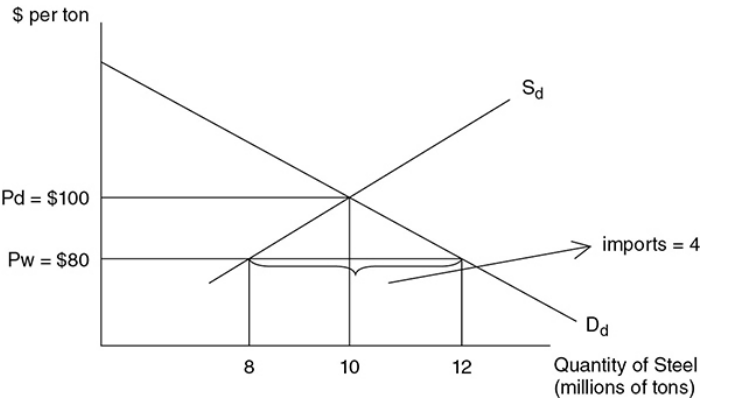
Economic Effects of the Tariff
Consumers pay higher prices and consume less steel
Consumer surplus has been lost
Domestic producers increase output
- Domestic steel firms are not subject to the tariff, so they can sell more steel at the price of $90 than they could at $80.
Declining imports
- Fewer tons of imported steel arrives in the United States.
Tariff revenue
The government collects $10 × 2 million = $20 million in tariff revenue. This is a transfer from consumers of steel to the government, not an increase in the total well-being of the nation.
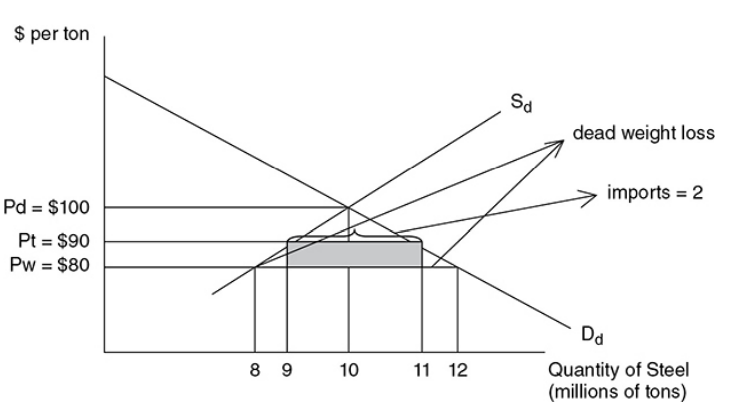
Inefficiency
- The world price was lower than the domestic price because it was more efficient to produce steel abroad and export it to the United States. By taxing this efficiency, the United States promotes the less efficient domestic industry and stunts the efficient foreign sector. As a result, resources are diverted from the efficient to the inefficient sector.
Deadweight loss now exists
Quotas
Import quota - A limitation on the amount of a good that can be imported into the domestic market.
With a quota, the government only allows two million tons to be imported. So the impact of the quota, with the exception of the revenue, is the same: higher consumer price and inefficient resource allocation.
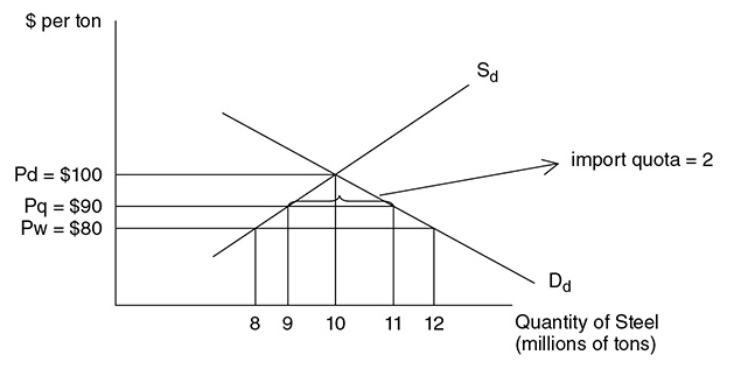
Tariffs and quotas share some of the same economic effects:
- Both hurt consumers with artificially high prices and lower consumer surplus.
- Both protect inefficient domestic producers at the expense of efficient foreign firms, creating deadweight loss.
- Both reallocate economic resources toward inefficient producers.
Tariffs collect revenue for the government, while quotas do not.